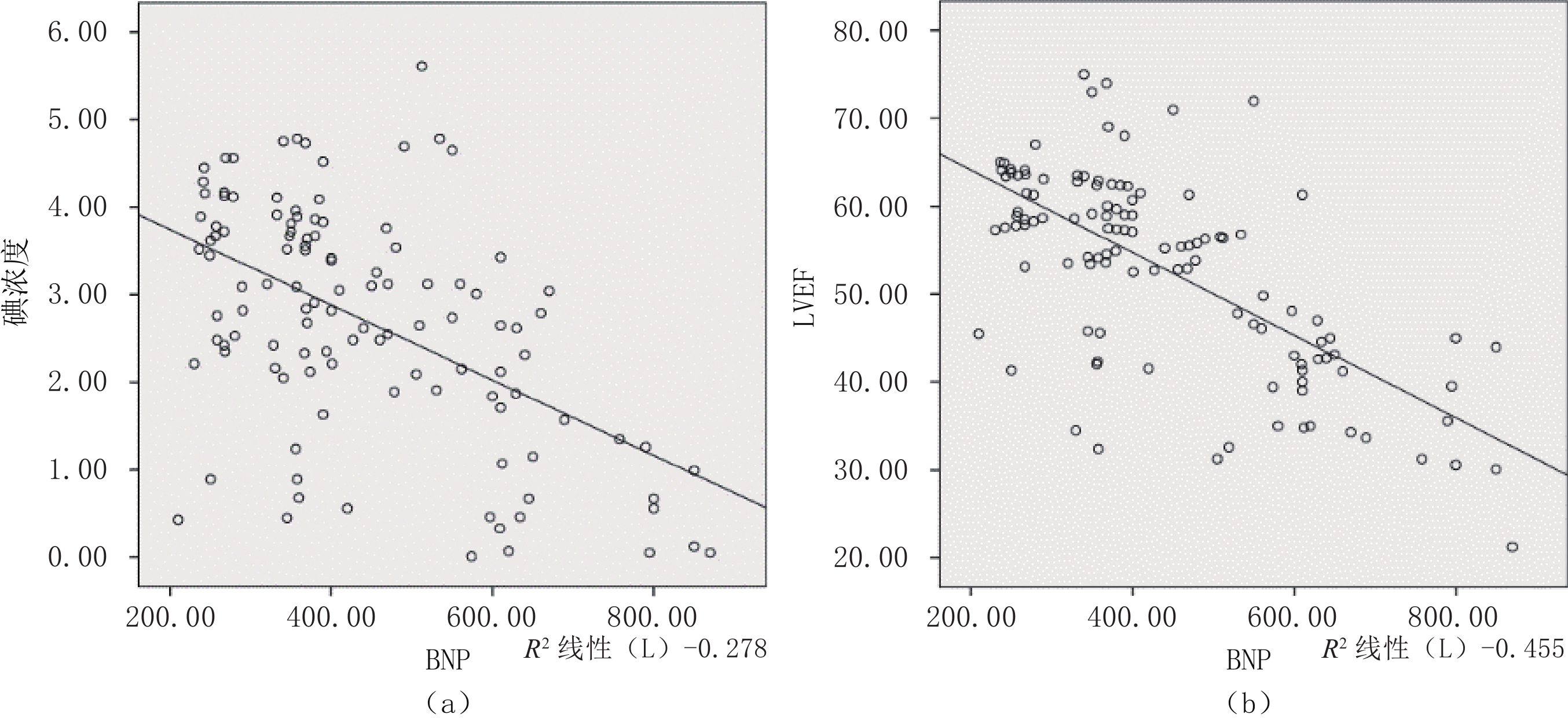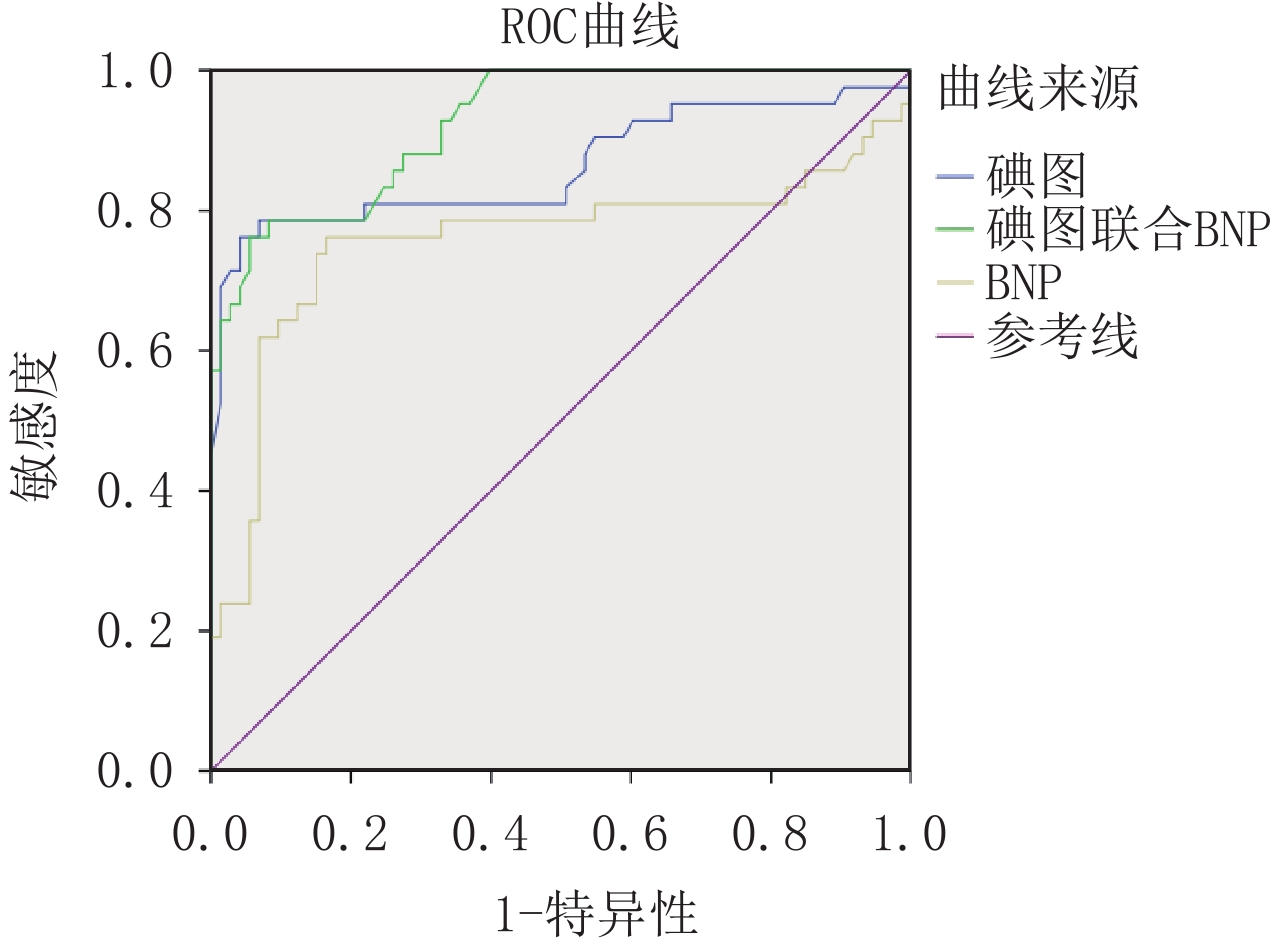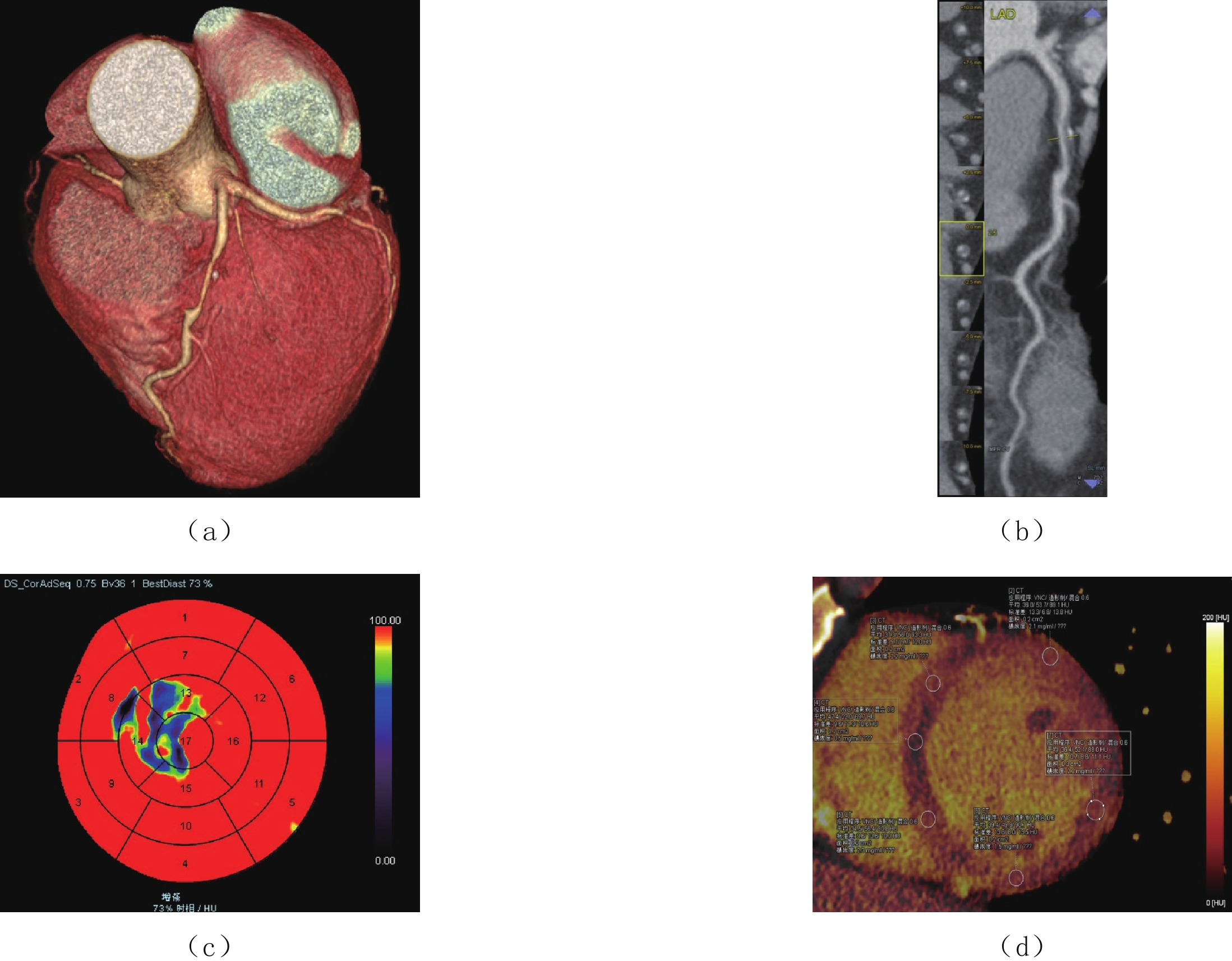Predictive Value of Dual-energy CT Left Ventricular Iodinogram Combined with Plasma BNP in the Development of Heart Failure after AMI
-
摘要: 目的:探讨双能量CT左室心肌碘图技术及血浆B型利钠肽(BNP)水平对急性心肌梗死(AMI)患者发生心力衰竭(HF)及严重程度的早期诊断及预测价值。方法:选取2018年1月至2019年12月本院收治的AMI患者,完成双能量冠状动脉CTA检查及血浆BNP检查,入院治疗1周内评估患者心功能分级。通过双能量冠脉CTA检查测量心肌碘含量用以评价患者CT心肌灌注情况。分析患者心肌碘含量、左心室射血分数及BNP水平指标间的相关性,对比HF患者不同Killip心功能分级组间心肌灌注情况、LVEF及BNP水平的差异。结果:共有115例AMI患者入组,其中42例纳入HF组,73例非HF组。两组间的心肌碘浓度、LVEF及BNP的差异均有统计学意义。梗死心肌碘浓度、LVEF与BNP水平呈负相关(<i<r</i<=−0.527、−0.674)。ROC曲线显示,心肌碘浓度联合BNP对于预测AMI后发生HF的AUC高于碘图、BNP的单独预测结果。42例AMI后HF患者不同Killip分级组之间,随着Killip分级的升高,血清BNP水平升高,LVEF及梗死心肌碘含量下降,并且不同分级组间BNP、LVEF、梗死心肌碘含量差异均有统计学意义。结论:双能量CT左室心肌碘图技术联合BNP水平对急性心肌梗死后心力衰竭的发生有预测价值,并与心力衰竭的临床严重程度有一定相关性。Abstract: Objective: To investigate the value of dual-energy CT left ventricular iodinogram imaging and plasma B-type natriuretic peptide level in the early diagnosis and prediction of heart failure and severity in patients with acute myocardial infarction. Methods: AMI patients admitted to our hospital from January 2018 to December 2019 were selected to complete dual-energy coronary artery CTA and plasma BNP examination, and cardiac function grading was assessed within 1 week after admission. Myocardial iodine content was measured to evaluate the myocardial perfusion on dual-energy CT. The correlation between myocardial iodine content, left ventricular ejection fraction and BNP level was analyzed, and the differences of myocardial perfusion, LVEF and BNP levels among different Killip cardiac function grading groups in HF patients were compared. Results: A total of 115 patients with AMI were enrolled, including 42 patients in HF group and 73 patients in non-HF group. There were significant differences in myocardial iodine concentration, LVEF and BNP between the two groups. Iodine concentration and LVEF were negatively correlated with BNP (<i<r</i<=−0.527, −0.674). The ROC curve showed that the AUC of myocardial iodine concentration combined with BNP in predicting HF after AMI was higher than that of iodine map and BNP alone. Among the 42 HF patients after AMI, with the increase of Killip grade, serum BNP level increased, LVEF and iodine content of infarct myocardial decreased, and there were statistically significant differences in BNP, LVEF and iodine content of infarct myocardial among different grade groups. Conclusion: Dual-energy CT left ventricular iodinogram combined with BNP level has predictive value on the occurrence of heart failure after acute myocardial infarction, and has a certain correlation with the clinical severity of heart failure.
-
Keywords:
- dual-energy CT /
- myocardial iodine maps /
- acute myocardial infarction
-
急性心肌梗死(acute myocardial infarction,AMI)是指冠状动脉突然闭塞而引起心肌缺血及损伤,严重者可导致心肌坏死的一种急性缺血性心脏病。疾病特点为发病急、病情重、病死率高,是临床最常见的心血管危重疾病之一。随着急诊经皮冠状动脉介入诊疗术(percutaneous coronary intervention,PCI)的开展,AMI的病死率有所下降,而心力衰竭(heart failure,HF)仍是AMI的重要临床并发症及患者死亡的重要原因[1-2],早期判断AMI后发生HF并开展个性化治疗对患者的预后有一定的价值。
双源双能量CT“一站式”成像技术,既可获得冠状动脉的解剖信息,又可用碘图来判断心肌灌注情况[3],可用来无创性评价缺血性心脏病患者的心肌情况。血浆B型利钠肽(B-type natriuretic peptide,BNP)水平对于AMI的诊断、监测有重大价值,同时对AMI后HF患者的预后有较高的预测价值[4-5],有助于指导临床治疗。
本文旨在分析AMI患者的CT心肌碘含量与血浆BNP的相关性,分析AMI后发生不同程度HF患者(Killip分级Ⅰ~Ⅳ)的心肌碘含量的差异,探究CT心肌碘含量联合血浆BNP对于AMI后发生HF预后的预测价值。
1. 资料与方法
1.1 研究对象
选择2018年1月至2019年12月本院收治的AMI患者115例为研究对象,收集所有患者的临床资料,涵盖年龄、性别、心肌梗死史、高血压史、糖尿病史、高脂血症史。所有患者均符合WHO和国际心脏病协会制定的关于AMI、心力衰竭的临床诊断标准[6-7]。
AMI诊断标准:存在急性心肌损伤伴急性心肌缺血的临床证据;检测到肌钙蛋白升高和/或下降且至少一次肌钙蛋白数值高于正常参考范围上限。同时至少存在一项以下的表现:①心肌缺血的症状;②新发缺血性心电图改变;③病理性Q波;④影像学证据表明新发的存活心肌缺失或新发的节段性室壁运动异常,且病因符合缺血性。
HF的诊断标准:①肺部下野湿性啰音,胸片见肺淤血,出现心率加快或者奔马律,心功能 Killip Ⅱ级或者以上;②突发呼吸困难等严重心力衰竭的典型临床表现;③心源性休克。排除标准:①因呼吸运动导致灌注错层、血流动力学不稳定;②碘对比剂过敏;③心律失常,病态窦房结综合征;④肝、肾功能不全;⑤冠状动脉搭桥或支架植入者;⑥合并恶性肿瘤;⑦合并严重感染。所有检查均获得患者知情同意,并经医院伦理委员会审定通过。
1.2 研究方法
1.2.1 BNP采集及实验室检查
所有患者均于入院后次日清晨空腹采集静脉血,分离血清后进行BNP实验室检查,采用荧光免疫分析仪进行检测。
1.2.2 双源双能量CT扫描方法及参数
采用Siemens SOMATOM Force CT第3代双源CT扫描仪。检查控制心率在75 bpm以下。检查过程中使用双筒高压注射器经右肘前静脉以约5 mL/s速率注射碘普罗胺(370 mgI/mL)50~60 mL,继而以相同速率注射50~60 mL生理盐水。
扫描方法:采用对比剂示踪自动触发扫描,触发点定于肺动脉主干层面的主动脉根部,触发阈值为CT值上升100 HU,延时4~6 s自动触发扫描。扫描范围由气管分叉至心脏膈面下1 cm,屏气扫描。扫描参数:A和B管电压分别为100 kV、sn 140 kV,自动管电流,开启实时动态剂量调节自动曝光,准直器192×0.6 mm,视野184 mm×184 mm,螺距0.15~0.28(随心率自动调整)。采集RR间期范围为30%~80%。Sequence扫描模式采用66 ms单扇区重建时间窗自动重建最佳舒张期和最佳收缩期图像(层厚0.75 mm,重建间隔0.5 mm,卷积函数bv36,图像矩阵512×512)。
1.2.3 CT心肌灌注图像重建及分析
采用西门子Syngo.via后处理工作站Dual Energy-Heart PBV图像后处理软件,综合分析舒张期及收缩期图像,评价并分析左心功能,得到左心室射血分数(left ventricular ejection fractions,LVEF)。
采用mono+后处理方法,在舒张期及收缩期重建左心室短轴位图像,按照美国心脏协会(AHA)17节段心肌分法进行各心肌节段碘含量测量,其中二尖瓣至乳头肌水平为基底段(对应心肌1~6节段)、乳头肌层面为中央段(对应心肌7~12节段)、乳头肌至心尖为心尖段(对应心肌13~16节段)。心尖第17节段在左心室长轴进行测量。每个节段选择连续的3个层面测量3次取平均值,层面间隔为2 mm,ROI大小为0.2 cm2。观察灌注减低或缺损节段,取平均值为心肌碘浓度值。
1.3 统计学分析
采用SPSS 23.0统计软件分析数据。计量资料以均数±标准差表示,计数资料以率表示。两组均数比较采用配对样本资料t检验,多组样本间两两比较采用单因素方差分析(ANOVA),相关性分析采用Pearson相关分析。对于P<0.05的危险因素进行多因素Logistic回归分析。将碘图及BNP进行二元Logistic回归分析,得到Logistic回归方程,获取联合预测因子。
采用受试者工作特征曲线(receiver operating characteristic curve,ROC曲线)评价碘图、BNP及联合预测因子预测HF发生的敏感性与特异性,并计算相应曲线下面积(area under curve,AUC)。以P<0.05为差异有统计学意义。
2. 结果
2.1 临床基本资料
根据入组标准,入组115例AMI患者,其中HF组42例(36.52%)、非HF组73例(63.48%)。两组间的既往心肌梗死史差异有统计学意义,而高血压史、糖尿病史、高脂血症史差异无统计学意义(表1)。
表 1 HF组与非HF组患者一般资料比较Table 1. Comparison of general data between HF group and non-HF group基本情况 组别 统计检验 HF组(n=42) 非HF组(n=73) χ2/t P 年龄/岁 68.15±6.32 59.90±7.12 4.357 0.095 男/女 24/18 45/28 0.225 0.635 心肌梗死史/例 4 18 3.947 0.047 高血压史/例 27 43 0.324 0.569 糖尿病史/例 15 24 0.096 0.757 高脂血症史/例 19 28 0.522 0.470 2.2 CT心肌灌注及BNP检查情况
对HF组及非HF组两组间的射血分数、心肌碘含量浓度及实验室检查结果进行对比,LVFE、心肌碘浓度、实验室检查BNP水平两组间差异均有统计学意义(表2)。
表 2 两组CT心肌灌注及实验室检查情况Table 2. CT myocardial perfusion and laboratory examination of the two groups检查项目 组别 统计检验 HF组(n=42) 非HF组(n=73) t P LVEF/% 39.85±6.23 60.14±5.31 18.503 0.001 心肌碘浓度/(mg/mL) 1.43±1.01 3.43±0.85 11.274 <0.001 BNP/(ng/L) 585.57±163.91 360.16±87.28 -8.261 0.002 2.3 多因素Logistic回归分析
对两组间有差异的指标既往心肌梗死病史、LVEF、BNP、心肌碘浓度进行Logistic回归分析,结果显示LVEF、BNP、心肌碘浓度具有统计学意义,而既往心肌梗死病史不具有统计学意义(表3)。
表 3 AMI后发生HF的危险因素分析Table 3. Risk factors of HF after AMI检验变量 标准误 OR值 95%CI P 心梗病史 0.593 0.780 0.925~1.018 0.408 LVEF 0.125 1.370 1.015~1.679 0.034 BNP 0.108 1.085 0.987~1.091 0.006 心肌碘浓度 0.463 1.276 0.679~2.324 0.012 2.4 Pearson相关分析
对所用入组患者的心肌碘浓度、LVEF、血浆BNP进行Pearson相关分析,结果表明(图1),心肌碘浓度、LVEF与BNP水平呈负相关(r=-0.527、-0.674)。
2.5 CT心肌灌注及血浆BNP水平对AMI后发生HF的预测价值
以所有入组患者碘图所示心肌碘浓度、BNP、碘图及BNP联合预测因子预测AMI后发生HF绘制ROC曲线(表4和图2)。
表 4 碘图、BNP及碘图联合BNP预测AMI后HF诊断效能的比较Table 4. Comparison of diagnostic efficacy of iodine map, BNP and iodine map combined with BNP in predicting HF after AMI指标 灵敏度/% 特异度/% AUC 碘图联合BNP预测 88.1 78.1 0.926 碘图 81.0 72.6 0.863 BNP 78.6 67.1 0.757 结果显示,碘图联合BNP对于预测AMI后发生HF的AUC为0.926(95%CI 0.879~0.972),高于碘图及BNP的单独预测结果,碘图的AUC为0.863(95%CI 0.780~0.946),BNP的AUC为0.757(95%CI 0.646~0.868)。
2.6 HF组不同Killip分级间心肌碘浓度、LVEF及BNP比较
根据Killip心功能分级,对AMI后发生HF的患者进行分组,分为KillipⅡ级、Ⅲ 级、Ⅳ 级3组。采用单因素方差分析(ANOVA)对不同分级之间的心肌碘浓度、LVEF及BNP进行比较。
结果表明,KillipⅡ级、Ⅲ 级、Ⅳ级3组患者的血清BNP水平显著高于AMI后非HF组;而心肌碘浓度、LVEF水平均显著低于AMI后非HF组。KillipⅡ级、Ⅲ 级、Ⅳ级3组间进行两两比较,结果表明,心肌碘浓度、LVEF及BNP水平差异均具有统计学意义。
心肌碘浓度、LVEF随着Killip分级升高而降低,BNP水平随着Killip分级升高而升高(表5)。图3为1例68岁男性患者,因胸痛2小时入院,Killip Ⅳ级,BNP 694 ng/L。
表 5 不同Killip分级间心肌碘浓度、LVEF、BNP比较情况Table 5. Comparison of myocardial iodine concentration, LVEF and BNP among different Killip grades分组 例数 心肌碘浓度/(mg/mL) LVEF/% BNP/(ng/L) 非HF组 73 3.42±0.85 60.14±5.31 360.16±87.48 Killip Ⅱ级 16 1.59±1.07ab 41.52±5.93ab 424.13±118.73ab Killip Ⅲ级 14 1.66±0.97ab 40.43±4.28ab 616.14±17.99ab Killip Ⅳ级 12 0.88±0.59ab 34.12±5.76ab 765.16±78.94ab 注:a.与非HF组比较,P<0.05;b.不同NYHA分级分组之间两两比较,P<0.05。 ![]() 图 3 男性患者,68岁。(a)(b)冠状动脉CTA 图像:左前降支管腔重度狭窄;(c)双能CT心肌灌注伪彩图:左心室第8、13、14、17节段灌注缺损;(d)左心室短轴位心肌碘图:缺损区碘浓度平均值为0.3 mg/mLFigure 3. Male patient, 68 years old. (a) and (b) show CTA images of coronary arteries: Severe stenosis of the left anterior descending branch. (c) shows dual-energy CT pseudo-color image of myocardial perfusion: Perfusion defects in left ventricular segments 8, 13, 14 and 17. (d) shows short axial myocardial iodinogram of the left ventricle: The mean iodine concentration in the defect area was 0.3 mg/mL
图 3 男性患者,68岁。(a)(b)冠状动脉CTA 图像:左前降支管腔重度狭窄;(c)双能CT心肌灌注伪彩图:左心室第8、13、14、17节段灌注缺损;(d)左心室短轴位心肌碘图:缺损区碘浓度平均值为0.3 mg/mLFigure 3. Male patient, 68 years old. (a) and (b) show CTA images of coronary arteries: Severe stenosis of the left anterior descending branch. (c) shows dual-energy CT pseudo-color image of myocardial perfusion: Perfusion defects in left ventricular segments 8, 13, 14 and 17. (d) shows short axial myocardial iodinogram of the left ventricle: The mean iodine concentration in the defect area was 0.3 mg/mL3. 讨论
AMI是比较常见的心血管疾病,同时也是引起心力衰竭最重要的原因之一,当患者发生AMI时,心肌缺血坏死容易引起间质水肿,从而进一步激活机体的免疫系统,引起炎症反应,使得心肌的收缩力明显减低或心肌收缩力不协调,最终导致心力衰竭的发生[8-9]。而AMI后发生HF的发病率比较高,早期无明显特异性,因此有部分患者容易错过治疗的最佳时间窗,从而引起不良心血管事件的发生。因此,早期预测AMI后发生HF并进行合理有效的治疗对改善患者的预后至关重要。
双源双能量冠脉CTA检查作为一种非侵入性、无创的影像方法,不仅可显示冠状动脉解剖学信息,还可以通过双能量左心室心肌碘图技术显示心肌灌注情况,融合了解剖学与功能学成像的检查技术,实现了以往不能同时进行冠脉成像和心肌灌注显像单次扫描的“一站式”检查,明确狭窄血管与灌注缺损的对应关系,提高冠心病心肌缺血的诊断准确性[10-11]。
近年来,多项研究表明血浆BNP水平能够准确反映心功能状态,对AMI后HF的发生有预测价值,并与HF的临床严重程度相关[10,12]。本研究首次尝试将影像上心肌灌注情况结合临床上BNP水平来评价及预测AMI后HF的发生及严重程度。
本研究发现,AMI后HF组患者既往心肌梗死病史显著高于非HF组,说明其可能是AMI患者并发HF的危险因素。这与既往研究[11-12]中,糖尿病、年龄也是AMI后发生HF的危险因素略有差别,这可能是由于本次研究样本量较少有关。本研究中HF组BNP水平明显高于非HF组,而LVEF低于非HF组,这与既往研究[4,13]相符,提示BNP水平、LVEF对预测AMI发生HF有一定的预测价值。
心肌灌注反映了流经心肌内冠状动脉血管网的血流[14],双能量CT左室心肌碘图技术通过对心肌内碘分布的评估(碘浓度)反映心肌灌注的情况。研究表明,冠状动脉CTA结合双能量心肌灌注碘图可进一步提高临床可疑心肌梗死患者诊断的准确性[15]。碘图的评价多采用主观评价伪彩图与客观测量心肌碘浓度相结合的方式进行。
本研究中AMI后HF组患者的心肌碘浓度明显低于非HF组,也证实了既往研究结果对于临床的指导作用。为了进一步探讨心肌碘浓度对于HF发生的预测价值,我们绘制了心肌碘浓度与AMI后发生HF的ROC曲线,结果显示,AUC为0.863,表明心肌碘浓度在预测AMI后HF的发生上有一定的价值。而特异性仅为72.6%。特异性较低的原因可能为碘图上显示灌注缺损区域其供血的冠状动脉管腔并未显示明显狭窄,或其他原因导致的心肌低灌注如心肌炎等。这与文献[16]报道一致,反映了冠状动脉功能学改变与解剖学上狭窄的不完全匹配。
心肌灌注成像对早期有心肌缺血症状但是心外膜并无明显冠状动脉狭窄患者的心肌微循环障碍有一定的诊断价值[17],反复发生冠状动脉微栓塞会导致冠状动脉微循环障碍和心力衰竭的发生[18],当发生心肌微循环阻塞时心肌内几乎没有心肌灌注[19],表现为心肌灌注缺损。随着CTP灌注缺损区域数量的增加,患者出现不良心血管事件的风险也有明显增加的趋势[20]。
本研究中反映心肌灌注的指标心肌碘浓度对于HF的严重程度也可能有预测价值,在一定程度上提示不良心血管事件的发生。入组患者的心肌碘浓度、LVEF与BNP水平呈负相关,对于Killip不同心功能分级之间的心肌碘浓度、LVEF及BNP进行比较,结果表明,随着心功能分级的升高,心肌碘浓度、LVEF随之降低,BNP水平随之升高。
本研究存在一定的不足。首先,本研究属于回顾性研究,只探讨了心肌碘含量、LVEF、BNP与住院期间AMI患者发生心力衰竭的相关性、严重程度及预测价值,未对远期预后做进一步研究,将进一步随访入组患者,以求进一步观察心肌灌注情况与患者远期预后的相关性。其次,本研究采用静息心肌灌注的方法,有一定的局限性,静息CTP图像依赖于与周边正常心肌组织的对比,当心肌灌注弥漫性减低时容易出现漏诊[21]。动态心肌灌注通过相关参数来定量评价组织灌注情况,对于高度钙化或心肌弥漫缺血应用价值较大。将进一步结合冠状动脉CTA图像,重点观察冠状动脉狭窄的分支血管供血区域的室壁灌注情况。
综上所述,双能量CT左室心肌碘图技术中的心肌碘浓度作为敏感的预测因子,在一定程度上能反映AMI患者心肌损伤的严重程度,并且能够预测AMI后HF的发生及严重程度。通过与血清BNP水平进行相关性分析,BNP水平越高,心肌碘含量越低的患者预后越差,越容易引起心力衰竭的发生。
-
图 3 男性患者,68岁。(a)(b)冠状动脉CTA 图像:左前降支管腔重度狭窄;(c)双能CT心肌灌注伪彩图:左心室第8、13、14、17节段灌注缺损;(d)左心室短轴位心肌碘图:缺损区碘浓度平均值为0.3 mg/mL
Figure 3. Male patient, 68 years old. (a) and (b) show CTA images of coronary arteries: Severe stenosis of the left anterior descending branch. (c) shows dual-energy CT pseudo-color image of myocardial perfusion: Perfusion defects in left ventricular segments 8, 13, 14 and 17. (d) shows short axial myocardial iodinogram of the left ventricle: The mean iodine concentration in the defect area was 0.3 mg/mL
表 1 HF组与非HF组患者一般资料比较
Table 1 Comparison of general data between HF group and non-HF group
基本情况 组别 统计检验 HF组(n=42) 非HF组(n=73) χ2/t P 年龄/岁 68.15±6.32 59.90±7.12 4.357 0.095 男/女 24/18 45/28 0.225 0.635 心肌梗死史/例 4 18 3.947 0.047 高血压史/例 27 43 0.324 0.569 糖尿病史/例 15 24 0.096 0.757 高脂血症史/例 19 28 0.522 0.470 表 2 两组CT心肌灌注及实验室检查情况
Table 2 CT myocardial perfusion and laboratory examination of the two groups
检查项目 组别 统计检验 HF组(n=42) 非HF组(n=73) t P LVEF/% 39.85±6.23 60.14±5.31 18.503 0.001 心肌碘浓度/(mg/mL) 1.43±1.01 3.43±0.85 11.274 <0.001 BNP/(ng/L) 585.57±163.91 360.16±87.28 -8.261 0.002 表 3 AMI后发生HF的危险因素分析
Table 3 Risk factors of HF after AMI
检验变量 标准误 OR值 95%CI P 心梗病史 0.593 0.780 0.925~1.018 0.408 LVEF 0.125 1.370 1.015~1.679 0.034 BNP 0.108 1.085 0.987~1.091 0.006 心肌碘浓度 0.463 1.276 0.679~2.324 0.012 表 4 碘图、BNP及碘图联合BNP预测AMI后HF诊断效能的比较
Table 4 Comparison of diagnostic efficacy of iodine map, BNP and iodine map combined with BNP in predicting HF after AMI
指标 灵敏度/% 特异度/% AUC 碘图联合BNP预测 88.1 78.1 0.926 碘图 81.0 72.6 0.863 BNP 78.6 67.1 0.757 表 5 不同Killip分级间心肌碘浓度、LVEF、BNP比较情况
Table 5 Comparison of myocardial iodine concentration, LVEF and BNP among different Killip grades
分组 例数 心肌碘浓度/(mg/mL) LVEF/% BNP/(ng/L) 非HF组 73 3.42±0.85 60.14±5.31 360.16±87.48 Killip Ⅱ级 16 1.59±1.07ab 41.52±5.93ab 424.13±118.73ab Killip Ⅲ级 14 1.66±0.97ab 40.43±4.28ab 616.14±17.99ab Killip Ⅳ级 12 0.88±0.59ab 34.12±5.76ab 765.16±78.94ab 注:a.与非HF组比较,P<0.05;b.不同NYHA分级分组之间两两比较,P<0.05。 -
[1] FACH A, BÜNGER S, ZABROCKI R, et al. Comparison of outcomes of patients with ST-segment elevation myocardial infarction treated by primary percutaneous coronary intervention analyzed by age groups (<75, 75 to 85, and >85 years); (Results from the Bremen STEMI Registry)[J]. American Journal of Cardiology, 2015, 116(12): 1802−1809. doi: 10.1016/j.amjcard.2015.09.022
[2] WEIR R, MCMURRAY J J V, VELAZQUEZ E J. Epidemiology of heart failure and left ventricular systolic dysfunction after acute myocardial infarction: Prevalence, clinical characteristics, and prognostic importance[J]. American Journal of Cardiology, 2006, 97(10A): 13F−25F.
[3] DELGADO C, M VÁZQUEZ, OCA R, et al. Myocardial ischemia evaluation with dual-source computed tomography: Comparison with magnetic resonance imaging[J]. Revista Espaola de Cardiología, 2013, 66(11): 864−870.
[4] 董宁超, 程国杰, 张弓, 等. 血BNP浓度对急性心肌梗死患者心力衰竭的早期预测效果[J]. 解放军预防医学杂志, 2019,37(6): 163−164. DONG N C, CHENG G J, ZHANG G, et al. Effect of serum BNP concentration on early prediction of heart failure in patients with acute myocardial infarction[J]. Journal of Preventive Medicine of Chinese People's Liberation Army, 2019, 37(6): 163−164. (in Chinese).
[5] ISLAM M N, ALAM M F, DEBNATH R C, et al. Correlation between Troponin-I and B-type natriuretic peptide level in acute myocardial infarction patients with heart failure[J]. Mymensingh Medical Journal, 2016, 25(2): 226−231.
[6] RYBICKI F J, UDELSON J E, PEACOCK W F, et al. 2015 ACR/ACC/AHA/AATS/ACEP/ASNC/NASCI/SAEM/SCCT/SCMR/SCPC/SNMMI/STR/STS appropriate utilization of cardiovascular imaging in emergency department patients with chest pain: A joint document of the american college of radiology appropriateness criteria committee and the american college of cardiology appropriate use criteria task force[J]. Journal of the American College of Cardiology, 2016, 67(7): 853−879. doi: 10.1016/j.jacc.2015.09.011
[7] ROFFI M, PATRONO C, COLLET J P, et al. 2015 ESC guidelines for the management of acute coronary syndromes in patients presenting without persistent ST-segment elevation: Task force for the management of acute coronary syndromes in patients presenting without persistent ST-segment elevation of the European Society of Cardiology (ESC)[J]. European Heart Journal, 2016, 37(3): 267−315. doi: 10.1093/eurheartj/ehv320
[8] KIM M S, LEE J H, KIM E J, et al. Korean guidelines for diagnosis and management of chronic heart failure[J]. Korean Circulation Journal, 2017, 47(5): 555−643. doi: 10.4070/kcj.2017.0009
[9] 中华医学会心血管病学分会, 中华心血管病杂志编辑委员会. 中国心力衰竭诊断和治疗指南2014[J]. 中华心血管病杂志, 2014,42(2): 98−122. doi: 10.3760/cma.j.issn.0253-3758.2014.02.004 Chinese Society of Cardiology, Editorial Board of Chinese Journal of Cardiology. Chinese guidelines for diagnosis and treatment of heart failure 2014[J]. Chinese Journal of Cardiology, 2014, 42(2): 98−122. (in Chinese). doi: 10.3760/cma.j.issn.0253-3758.2014.02.004
[10] 毛懿, 杨跃进, 张健, 等. 急性心肌梗死患者血B型利钠肽水平与心功能的相关性和诊断心力衰竭的价值[J]. 中华心血管病杂志, 2009,37(3): 218−222. doi: 10.3760/cma.j.issn.0253-3758.2009.03.005 MAO Y, YANG Y J, JIAN Z, et al. The relationship between plasma BNP level and the left ventricular dysfunction parameters in patients with acute myocardial infarction and its value in diagonosing heart failure[J]. Chinese Journal of Cardiology, 2009, 37(3): 218−222. (in Chinese). doi: 10.3760/cma.j.issn.0253-3758.2009.03.005
[11] 李睿, 栾波, 段娜, 等. 辽西不同地区急性心肌梗死相关危险因素比较分析[J]. 中国循证心血管医学杂志, 2018,10(3): 300−303. doi: 10.3969/j.issn.1674-4055.2018.03.11 LI R, LUAN B, DUAN N, et al. Comparative analysis of risk factors related to acute myocardial infarction in different areas of western Liaoning[J]. Chinese Journal of Evidence-Based Cardiovascular Medicine, 2018, 10(3): 300−303. (in Chinese). doi: 10.3969/j.issn.1674-4055.2018.03.11
[12] 张胜豪, 刘恒亮, 毛磊, 等. 血清糖类抗原125及脑钠肽水平对心肌梗死后心力衰竭发生及严重程度的预测价值[J]. 中国动脉硬化杂志, 2019,27(1): 55−60. doi: 10.3969/j.issn.1007-3949.2019.01.011 ZHANG S H, LIU H L, MAO L, et al. Predictive value of serum carbohydrate antigen 125 and brain natriuretic peptide levels in the occurrence and severity of heart failure after myocardial infarction[J]. Chinese Journal of Arteriosclerosis, 2019, 27(1): 55−60. (in Chinese). doi: 10.3969/j.issn.1007-3949.2019.01.011
[13] 朱志远, 戴军, 王海燕, 等. 急性心肌梗死患者血清hs CRP/PAB、NT-pro BNP、LVEF水平与心力衰竭发生的相关性[J]. 中国医药导刊, 2019,21(7): 392−395. doi: 10.3969/j.issn.1009-0959.2019.07.003 ZHU Z Y, DAI J, WANG H Y, et al. Correlation between serum hs CRP/PAB, NT-pro BNP, LVEF Levels and heart failure in patients with acute myocardial infarction[J]. Chinese Journal of Medicinal Guide, 2019, 21(7): 392−395. (in Chinese). doi: 10.3969/j.issn.1009-0959.2019.07.003
[14] DANAD I, SZYMONIFKA J, SCHULMAN-MARCUS J, et al. Static and dynamic assessment of myocardial perfusion by computed tomography[J]. European Heart Journal Cardiovasc Imaging, 2016, 17(8): 836−844. doi: 10.1093/ehjci/jew044
[15] 韩瑞娟, 孙凯, 李坤成, 等. 第二代双源CT双能量心肌灌注成像对心肌梗死的诊断价值[J]. 中华诊断学电子杂志, 2015,3(3): 17−21. HAN R J, SUN K, LI K C, et al. Diagnostic accuracy of the second generation dual-source dual-energy CT myocardial perfusion imaging in patients with suspicious myocardial infarction[J]. Chinese Journal of Diagnostics (Electronic Edition), 2015, 3(3): 17−21. (in Chinese).
[16] SCHWARZ F, RUZSICS B, SCHOEPF U J, et al. Dual-energy CT of the heart−Principles and protocols[J]. European Journal of Radiology, 2008, 68(3): 423−433. doi: 10.1016/j.ejrad.2008.09.010
[17] HO K T, ONG H Y, TAN G, et al. Dynamic CT myocardial perfusion measurements of resting and hyperaemic blood flow in low-risk subjects with 128-slice dual-source CT[J]. European Heart Journal Cardiovasc Imaging, 2015, 16(3): 300−306. doi: 10.1093/ehjci/jeu200
[18] NICCOLI G, SCALONE G, LERMAN A, et al. Coronary microvascular obstruction in acute myocardial infarction[J]. European Heart Journal, 2016, 37(13): 1024−1033. doi: 10.1093/eurheartj/ehv484
[19] 马海彦, 王玉权, 谢光友, 等. 动态CT心肌灌注成像定量心肌血流量与ST段抬高心肌梗死患者肌钙蛋白水平及左心室功能受损的相关性[J]. 实用医学杂志, 2020,36(10): 1371−1375. doi: 10.3969/j.issn.1006-5725.2020.10.020 MA H Y, WANG Y Q, XIE G Y, et al. Dynamic CT myocardial perfusion imaging with quantitative MBF correlated with troponin level and impaired left ventricular function in patients with ST− Segment elevation myocardial infarction[J]. Journal of Practical Medicine, 2020, 36(10): 1371−1375. (in Chinese). doi: 10.3969/j.issn.1006-5725.2020.10.020
[20] MEINEL F G, PUGLIESE F, SCHOEPF U J, et al. Prognostic value of stress dynamic myocardial perfusion CT in a multicenter population with known or suspected coronary artery disease[J]. American Journal of Cardiology, 2017, 208(4): 761−769.
[21] 赵娜, 高扬. 心脏功能学CT成像技术的研究及应用现状[J]. 中国循环杂志, 2020,35(11): 1139−1143. doi: 10.3969/j.issn.1000-3614.2020.11.016 ZHAO N, GAO Y. Research and application status of CT imaging in cardiac function[J]. Chinese Circulation Journal, 2020, 35(11): 1139−1143. (in Chinese). doi: 10.3969/j.issn.1000-3614.2020.11.016
-
期刊类型引用(2)
1. 王勇力,黄秀红,罗敏,刘周敏. 基于TLR4/NF-κB信号通路构建老年急性心肌梗死病人心力衰竭发生风险的预测模型及验证. 中西医结合心脑血管病杂志. 2024(17): 3189-3193 .  百度学术
百度学术
2. 吴浩堂,李晓莉,罗伟权,刘娟娟,吴彬祥,赵永. 实时三维经胸超声心动图联合血清BNP、sST2对心肌梗死后心力衰竭的诊断价值. 现代生物医学进展. 2024(18): 3522-3528 .  百度学术
百度学术
其他类型引用(1)



 下载:
下载:





